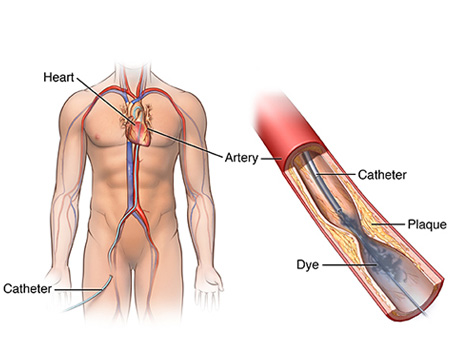Coronary Angiography (Radial)

Who requires coronary angiography?
Coronary angiography is usually recommended to patients who are at increased risks of a heart attack which includes people with:
- Acute MI ( heart attack)
- Unstable angina
- Effort engine with positive stress test
- Positive stress test
- Cardiomyopathy / heart failure
- Congenital heart defects
- Valvular heart diseases
How to prepare for the test
- The patient should not eat or drink anything starting 4-6 hours prior to the test
- Do not take any medication without the prior notice of your doctor
- Carry your medicines along
- Patients who are on insulin need to ask their doctors whether they can take their daily dosage or not
- The patient is required to empty his/her bladder and wear a hospital gown
- All the metallic items, pins, jewellery, glasses are to be removed before the test
The arterial sheath is introduced through the wrist or groin . The concerned area will be numbed using local anaesthetics such that the patient does not feel any pain or discomfort. The contrast material is slowly injected into the catheter following which the x-ray images are taken to monitor the flow of blood and detect any obstruction. The whole procedure lasts for 15-20 mins.
WHAT HAPPENS AFTER THE PROCEDURE?
Once the procedure is over, the arterial sheath is carefully removed and the punctured site is covered. The patient is taken to the recovery area where he/she is monitored for any complication. Once the patient is stable he/she can be discharged after 3/4 hours or shifted to their own room.
What happens after the procedure?
Once the procedure is over, the catheter is carefully removed and the incision site is covered. The patient is taken to the recovery area where he/she is monitored for any complication. Once the patient is stable he/she can be shifted to his own room.
Some important guidelines that are to be followed after the procedure include:
- The patient is required to lie flat for several hours to avoid bleeding especially if the catheter was arterial sheath was introduced via the groin.
- While majority of patients are discharged on the same day, others might be required to stay overnight.
Benefits of coronary angiography
Here are a few benefits of coronary angiography:
- It helps to detect the narrowing or obstruction of the coronary artery, thereby aiding the doctors in figuring out the best corrective treatment.
- It generates very precise results.
- It can help to detect the blockage even before the symptoms are evident, thereby reducing the risks of cardiac arrest.
- It involves minimal to no discomfort.
- It can help to monitor the flow of blood via the coronary artery as well as determine how much blood flow has been affected
- Patients who have undergone coronary bypass surgery in the past can undergo the procedure to determine whether his grafts are patent.
Are there any risks involved?
Just like any other medical procedure, coronary angiography too comes with slight risks that include:
- Rare Allergic reaction to the contrast material used during the procedure
- Arrhythmias
- Small risk of Renal damage
- Small risk Internal bleeding
- Rare risk increased risks of stroke


